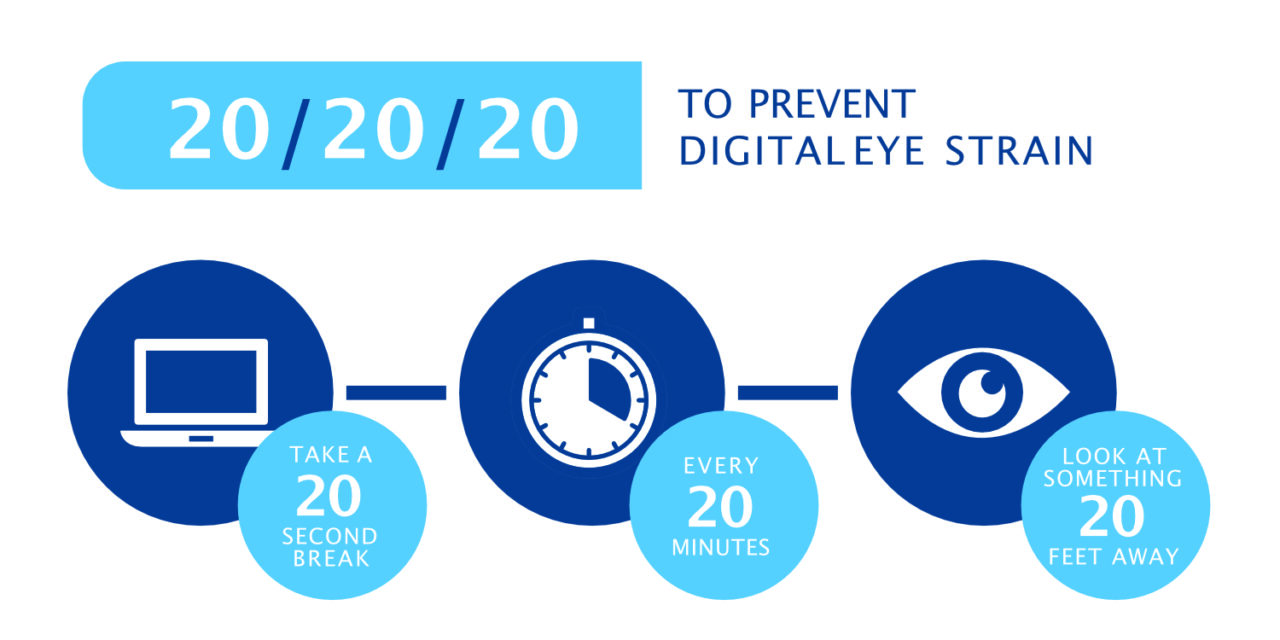In 2020, the average person spent 15%1 more time on screens than in 2019, which accounts for more than half of the day. The COVID-19 pandemic continually redefines our lifestyle as we conform to new routines and habits, but the effect on our vision cannot be understated. Vision is one of our most valuable senses as 80% of our perception is through sight. Despite the added stress to our eyes, there are some easy steps we can take to protect them.
Eye Strain
Increased visual demands due to work-from-home and virtual school environments add a variety of stressors to our ocular system, including glare, defocus, dryness, fatigue, and discomfort. Consequently, we may experience eye redness, blurry vision, double vision, headaches, and avoidance of tasks.

Also, a standard bifocal or progressive lens may not fit all visual needs. You may need a different prescription or lens for your specific workspace setup. Different lens coatings can also reduce glare, such as an anti-reflective coating. Phones, tablets, computers, and television screens emit a blue light that can disrupt your natural sleep cycles. To enhance sleep, consider decreasing evening screen time or set devices to night mode. If this is not feasible, blue-blocking lenses can be beneficial4.
Mask-Induced Fogging
Wearing masks to prevent transmission of COVID-19 has caused a new nuisance for people who wear glasses—fogging of lenses. This condensation is due to warm air from our mouth and noses escaping the mask. The mask is less effective if it is not secured to your face, so consider masks with a nose bridge or a tighter-fitting mask. To prevent lens fogging:
- Tape the top of your mask to your skin, using sports or medical tape.
- Fold a tissue and place inside the mask to soak up moisture.
- Clean the lens with a mild soap and water, followed by drying with a clean soft cloth.
- Purchase a de-fogging spray and use every few hours.
- Visit an optometrist to see if you are a candidate for contact lenses.
Ocular Health
If you are delaying your eye exam due to the pandemic, know that doctors’ offices have modified spaces and procedures to adhere to COVID-19 protocols and provide safe environments. Many ocular conditions have no obvious signs or symptoms, and early diagnosis and treatment can help prevent vision loss or eye discomfort. American Optometric Association recommends comprehensive eye exams every 1–2 years, which includes various testing, including dilation to evaluate the inside and back of the eye5. If you have a history of an eye condition or medical conditions or medications with potential ocular manifestations, you may need more frequent exams. If you are experiencing a new vision or eye problem, visit an optometrist.
Dr. Shaleen Ragha is an optometrist in Memphis with special interest in ocular disease. She completed her residency at the Memphis VAMC and currently trains students at Southern College of Optometry, serves as a clinical attending at The Eye Center, and sees patients at FocalPoint at Crosstown Concourse. To schedule an appointment, call 901.252.3670.
Sources:
1 Insider Intelligence. US Adults Added 1 Hour of Digital Time 2020. eMarketer. January 6, 2021. <https://www.emarketer.com/content/us-adults-added-1-hour-of-digital-time-2020>
2 The Impact Social Media and Proximity of Digital Screens is Having on Our Eyes. Bausch and Lomb. June 20, 2017. <https://bausch.co.uk/news/blink-rate>
3 Office Ergonomics: Your How-To-Guide. MayoClinic. April 27, 2019. <https://www.mayoclinic.org/healthy-lifestyle/adult-health/in-depth/office-ergonomics/art-20046169>
4 Porter D. Blue Light and Digital Eye Strain. American Academy of Ophthalmology. December 10, 2020. <https://www.aao.org/eye-health/tips-prevention/blue-light-digital-eye-strain>
5 Comprehensive Eye Exams. American Academy of Optometry. <https://www.aoa.org/healthy-eyes/caring-for-your-eyes/eye-exams?sso=y>
Photo and illustrations by Philip Tribble







